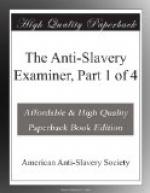[Footnote D: See law of Louisiana, Martin’s Digest, 6, 10. Mr. Bouldin, a Virginia slaveholder, in a speech in Congress, Feb. 16, 1835, (see National Intelligencer of that date,) said “he knew that many negroes had died from exposure to weather.” Mr. B. adds, “they are clad in a flimsy fabric that will turn neither wind nor water.” Rev. John Rankin says, in his Letters on slavery, page 57, “In every slaveholding state, many slaves suffer extremely, both while they labor and while they sleep, for want of clothing to keep them warm. Often they are driven through frost and snow without either stocking or shoe, until the path they tread is died with their blood. And when they return to their miserable huts at night, they find not there the means of comfortable rest; but on the cold ground they must lie without covering, and shiver while they slumber.” ]
[Footnote E: See law of Louisiana, act of July 7, 1806, Martin’s Digest, 6, 10-12. The law of South Carolina permits the master to compel his slaves to work fifteen hours in the twenty-four, in summer, and fourteen in the winter—which would be in winter, from daybreak in the morning until four hours after sunset!—See 2 Brevard’s Digest, 243. The preamble of this law commences thus: “Whereas, many owners of slaves do confine them so closely to hard labor that they have not sufficient time for natural rest: be it therefore enacted,” &c. In a work entitled “Travels in Louisiana in 1802,” translated from the French, by John Davis, is the following testimony under this head:—
“The labor of Slaves in Louisiana is not severe, unless it be at the rolling of sugars, an interval of from two to three months, then they work both night and day. Abridged of their sleep, they scarce retire to rest during the whole period.” See page 81. On the 87th page of the same work, the writer says, "Both in summer and winter the slaves must be in the field by the first dawn of day." And yet he says, “the labor of the slave is not severe, except at the rolling of sugars!” The work abounds in eulogies of slavery.
In the “History of South Carolina and Georgia,” vol. 1, p. 120, is the following: “So laborious is the task of raising, beating, and cleaning rice, that had it been possible to obtain European servants in sufficient numbers, thousands and tens of thousands MUST HAVE PERISHED.”




